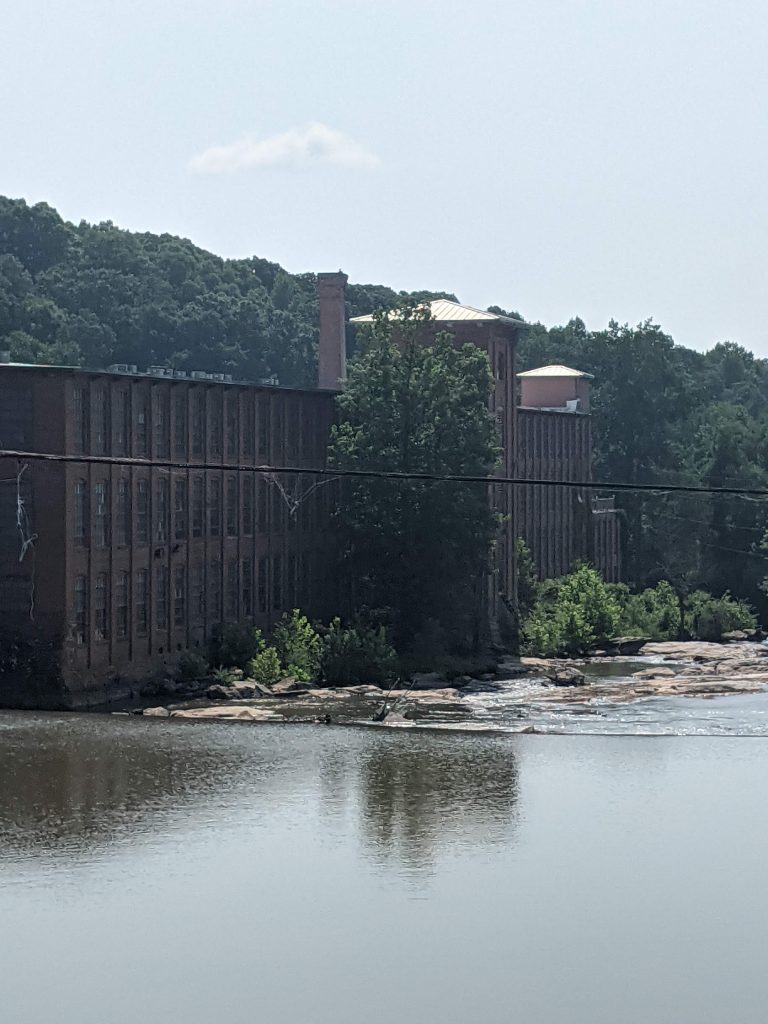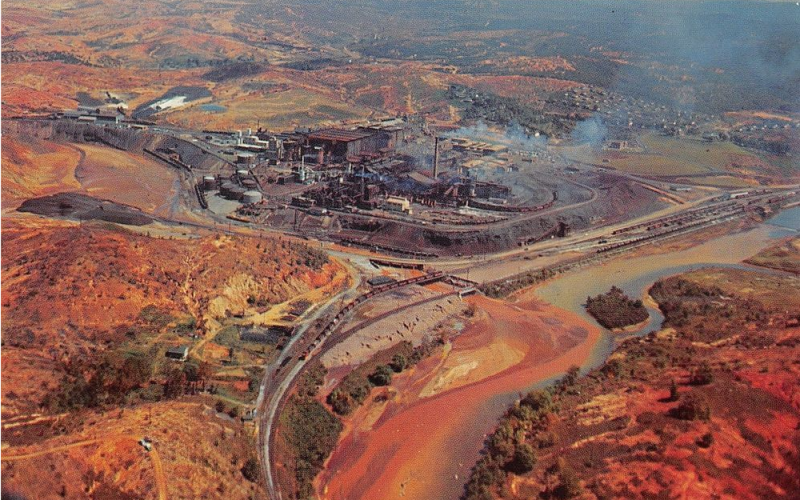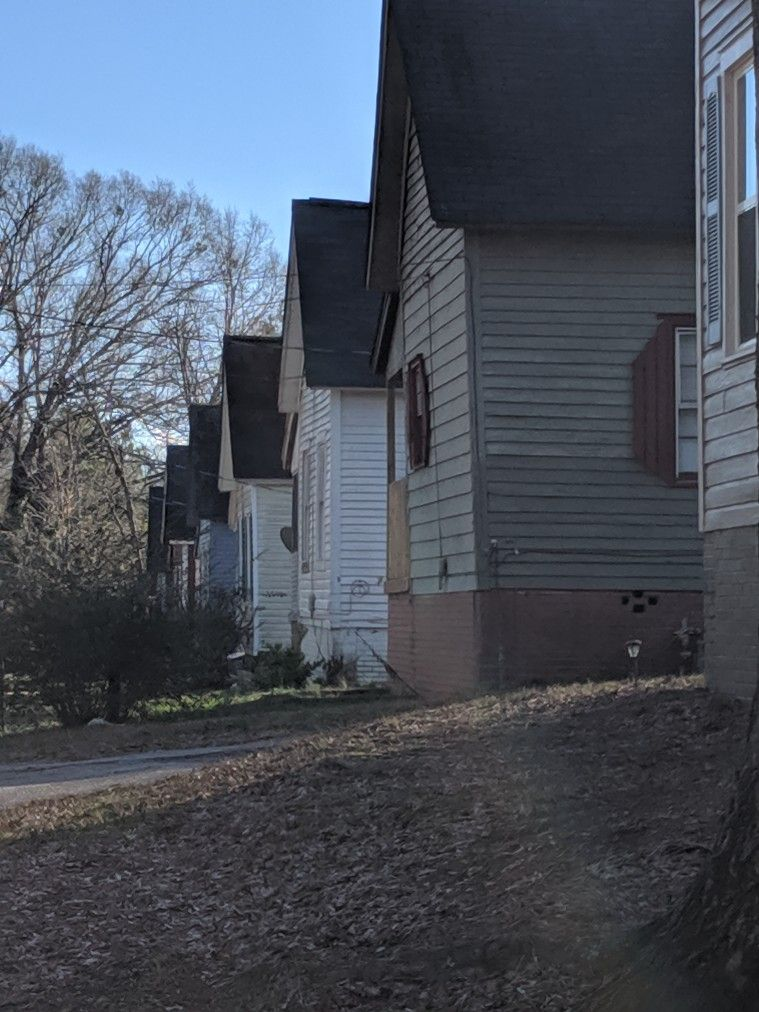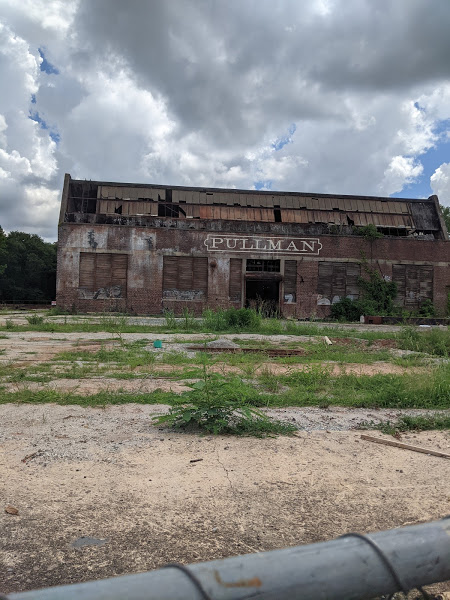We have touched on the idea of the “company town” a few times in the past, and this seems like a good time to review it a little bit. “Company town” is where some huge company is the dominant force in some sort of Little Southern Town, and that carries with it some benefits, and also some risks for the locals.
The reason that it is interesting at the moment is the announcement of a big ground breaking and huge factory to make electric vehicles on the other side of Rutledge from us.
We’re telling you this because among other things, we like surrounding ourselves with art, literature, things of beauty, and nice flavors and fragrances. We call all of this “Human Scale Living”. There’s also a historical context, which we have seen a lot in our Back Roads Travel.
Historical Background
“Company Towns” have gone on approximately as long as there have been “companies” that is, the industrialization period in Europe and North America. These did not actually originate in the South. The pioneer of this is the Lowell Mill in Massachusetts, which, in order to attract enough employees, actually built a dormitory for some of the “mill girls”.
This proved to be such a great idea that it was copied repeatedly and there are an abundance of these towns all over the Northeast, and it grew beyond the textile business. The fun town of Hershey PA was set up by the company as a pleasant, comfortable place for the local chocolate workers to live and work close to the shop.

Naturally if a majority of the local residents are working for the same company like this, the local politicians and political system are affected. Do we need to go into too much detail on the little mining towns that sprung up in West Virginia in the same way? The bosses in these places set the rent, food prices, and basically ran the whole show. This became similar enough to sharecropping from the standpoint of exploitation of cheap labor.

Places Near Us
There is actually a place near us like this, which we visited the other day in Copperhill. From that you can deduce the effects of this from an environmental standpoint. I guess things are better now.
I will refer the reader to the song “Sixteen Tons” by Tennessee Ernie Ford for reference. There were safety issues, and the whole thing got out of hand in the first US Depression when unionization started.
Side issue: We forgot to mention Tennessee Ernie in “The Ultimate Southern Music Road Trip” guide book but we will be sure to put him into the second edition. We already have a stop in Bristol, which is his ironic home town.
Local References
Well, in fact, you can see examples of these little mill houses and mill towns all over this area. Our favorite ones are in Monroe, which we talked about in the blog post below, but there are some in Social Circle and elsewhere. The ones in Dalton are particularly interesting, in fact, as we will see later.

Also, this whole strategy sort of fit into the local culture in this area. In “Big Southern Towns: The Dime Tour” we talked a lot about social organization. The “Plantation System” such as it was basically had it that a place ought to be run by a local emperor, and there were sufficient numbers of people in the system who had a stake in it that it went on that way for a long time, and is still going on that way.
The caricature of this was “Boss Hogg” who supposedly owned the bulk of Hazzard County in the “Dukes of Hazzard” who we also visited on the same trip. If you want to see some examples of this, you might want to take a trip to Porterdale, which has some very interesting old structures left from this era, where Mr. Porter and his sons ran the place for a few years.
The “New South”
This is what happened. In the late 1970’s and early ‘80’s, the Japanese auto companies were starting to come in to the US to build assembly plants.
They found out that in a lot of these ‘Little Southern Towns” the local political class was so starved for development that they would bend over backward to welcome them. There is an article in Slate Magazine linked in the Links and References that tells the story better than we can.
Because of low cost labor, cheap power from the Federally subsidized TVA projects, and wide open spaces, there sprung up sort of an arms race among the states and localities in this area. The ones that were able to provide the best tax breaks, cheapest land, best sewage treatment and other benefits to these companies got the plants.
Some may call this “corporate welfare.”
We should also talk about the Southern dislike for the “Union Movement.” This is basically a religious argument like many arguments we have probed. Nothing you can do or say will convince anybody otherwise, so it is best to remember the Prime Directive and sort of move on.
In “Big Southern Towns” we explored the general dislike of a central authority and immigrants in this region, so for the moment, I will just attribute it to that. There is an underlying culture among the “working class” here that what is good for the company is good for them, which is also an artifact of the plantation system.
Side point: Some of this shows up in country music, which has a lot of stories about how you should be content to go home from your factory job and drink cheap beer. Maybe someday you will be able to afford a horse.
What do you get for this?
There are a couple of fun towns in Tennessee to look at as an example, both in a place called Williamson County, which is not too far from Nashville.
The town of Franklin, which is Miley Cyrus’ home town, has grown in population from 9000 in 1970 to 83,000 today. There is a Nissan plant nearby, and a lot of hospitals, and of course it is commuting distance from Nashville now.
The town of Spring Hill, which is the home of the huge Saturn plant that GM built went from a population of about 1500 in 1990 to about 50,000 today.
The population of Williamson County, which has both of these towns, has grown from 126,000 to 250,000 between the years 2000 and 2020 and has become the state’s wealthiest county.
In this case, the whole place went from pasture land to a sea of mansions and also cookie cutter homes and annoying fast food places. Whether Miley is a net improvement is yet to be seen.
So what are the side effects?
The main one seems to be the idea that it changes the place. It goes from pastures and fields to giant factories and fast food places. A younger, more lively population shows up and there are stresses on the school system and the local jail, if you know what I mean. There is a fun scholarly article that I linked below that studies the economic impact after 20 years of the BMW and Mercedes experience in Greenville and Tuscaloosa, respectively.
The punch line of that is because of supply chain effects, and the ripple effect, these areas experienced job growth outside the place of about 2 jobs for every 1 that comes because of the actual plant. So that makes at least some people happy. It also says that the benefits are less than what were “estimated” in the original assessment. Who knew that someone in the automotive industry trying to sell you something would exaggerate?
But, they also experienced chaos growth, and if you have ever driven by these places, like we have in the various Little Southern Town and Southern Music Road Trips, you know that it changes the image of the community.

The Long Term
Well, in the long term, as Adam Smith says, we are all dead.
The people that make the actual decisions are typically middle aged at the time they make them. They roll around naked in piles of money. Maybe they move to someplace where they can be out in the “country”. Costa Rica is supposed to be nice.
What we do know is that like everything, the life cycle of an automotive place is finite. Invariably, a cheaper place is found to assemble cars, where the local citizens are willing to subsidize the place even more. If you want to see an example of what happens when a giant manufacturing place shuts down, go to either Augusta or Macon, which still have huge white elephant manufacturing places that are sitting empty.
In fact, the examples we talked about above, Monroe and Porterdale have that in common. The company went away, they were stuck with a huge building with nothing in it, and it took a few decades for them to figure out a use for them. Porterdale is just now coming around. Monroe, the antique capital, is a tribute to what once was, and they are selling the artifacts of the past. Most of the Little Southern Towns have a place that is too expensive to demolish.
In fact, there is a place in Newborn like that. The Van Gogh exhibit in Atlanta was held in the Pullman Yards, which is the kind of place we are talking about. Someone with deep pockets is trying to revive it now.
The difference is that in 1900 people built buildings to last 100 years. Now, of course, they don’t.
The Worst Case Scenario
We have been to a place that we called “The Little Southern Town Blues” town, where the mill shut down, they dozed it to the ground, and it had significant lasting impact on the town. In that case it was much worse than “sleepy.” There is a big population of bored, under-educated people. At least there are plenty of places to get your hair and nails done.
We also almost forgot about the Granite Capital, which also has a few places to buy antiques and get your hair done.
There is no naked money swimming, to the extent we were able to tell, in either of these places.
The giant Saturn plant in Spring Hill shut down for about a decade, but GM put a billion dollars into it, and it is now making electric Cadillacs.
The rest of these places have not been around long enough to die and then be reborn.
There is another fun link below which is a list of closed automotive plants, of which there are a lot. For the benefit of those who are not as good at math as we are, the average length of time these things remain open is about 20 years. Most of these places are shut down and bulldozed, but a few are revived as office parks or warehouses. It sort of depends on the residual economic value, if any.
It doesn’t really say that any of them are hauled off and turned into cotton fields, or woods for that matter.
The Most Likely Scenario, for awhile.
Well, it could end up being a place like Dalton, which has a population of hard working people, there is a lot of Hunt Brothers Pizza, and about half of the population is immigrants. At that place, they turn their old factories into factories, and their little mill houses are still little mill houses.
It’s not particularly beautiful though. We like effort and beauty in all of its forms. You would like Madison better.
So now what?
As we are so fond of saying, the world is chaotic, and there are no guarantees on anything.
At least it’s not a landfill we’re talking about. Yet.
One of the things we are also so fond of saying is that the “good old days” is now. In a 200 year old town, everything was once something else. Do you want to go to downtown Madison in about 1940? There was coal smoke, cotton dust, fecal matter, and other sources of annoyance that would not be tolerated today. The life expectancy was about 47. The streets were not paved with anything.
We have a business to run, of course, and so the word “should” does not appear in any of this. People will do what they do, without thinking too much about what it will be like in 21 years.
Be there in the square, while it is there.
Links and References
Mill Towns
https://en.wikipedia.org/wiki/Lowell_mills
https://en.wikipedia.org/wiki/Hershey,_Pennsylvania
https://en.wikipedia.org/wiki/Mill_town#United_States
https://coalheritage.wv.gov/coal_history/Pages/Company-Towns.aspx
Copperhill
Sixteen Tons
https://en.wikipedia.org/wiki/Tennessee_Ernie_Ford
The Quest for Boss Hogg
Local subsidies for offshore auto makers
Southern Dislike for Unions
Franklin TN
https://en.wikipedia.org/wiki/Franklin,_Tennessee
Williamson County TN
https://en.wikipedia.org/wiki/Williamson_County,_Tennessee
Spring Hill TN
https://en.wikipedia.org/wiki/Spring_Hill,_Tennessee
Economic impact of BMW and Mercedes
https://rrs.scholasticahq.com/article/8539.pdf
Closed Automotive Plants
https://en.wikipedia.org/wiki/List_of_former_automotive_manufacturing_plants
PS: It would be terrible if we didn’t have a link to “Little Southern Towns” as well.
![]()
